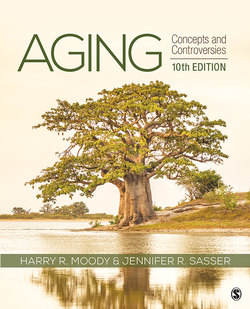Читать книгу Aging - Harry R. Moody - Страница 62
На сайте Литреса книга снята с продажи.
Successful Aging or the Imitation of Youth?
ОглавлениеModern society, perhaps especially American society, seems to regard aging as something to be denied or concealed. Women are freed, happily, from the corsets and similar instruments of torture that fashion once decreed. But a massive and inventive cosmetics industry does its best to persuade middle-aged and elderly women—and, increasingly, men—that they will lead happier lives if they change their hair color from gray to some improbable shade of blonde or red, camouflage their hair loss, and cover, erase, or abrade their wrinkles.
Photographs that advertise the products in question show people who are invariably young in appearance; photographer and makeup artist collaborate to send the incessant message of youth. And what cosmetics and computer-enhanced photography cannot do, plastic surgery offers to accomplish. The implication of all this information and misinformation is that the ultimate form of successful aging would be no aging at all. A psychologist might be tempted to say that underlying this denial of the aging process is a more deep-seated denial: refusal to acknowledge the fact of human mortality and the inevitability of death.
Our view of successful aging is not built on the search for immortality and the fountain of youth. George Bernard Shaw, when he was in his nineties, was asked whether he had any advice for younger people. He did. “Do not try to live forever,” said Shaw, “you will not succeed.” Or, as psychologist Carol Ryff put it in a thoughtful article, “Ponce de León missed the point.”
In short, successful aging means just what it says—aging well, which is very different from not aging at all. The three main components of successful aging—avoiding disease and disability, maintaining mental and physical function, and continuing engagement with life—are important throughout life, but their realization in old age differs from that at earlier life stages….
Old age has been called a “roleless role,” a time when it is no longer clear what is expected of the elderly person or where he or she can find the resources that will make old age successful.
For earlier life stages, the expectations are clearer. Children are expected to attend school; in fact, they are legally required to do so. Able-bodied adults are expected to be employed or to be actively seeking paid employment. Parents of young children are expected to care for them. None of these societal expectations generates perfect compliance, but all of them are felt and most of them are backed by law.
The years after child-rearing and employment present a sharp contrast to these expectational patterns and arrangements for their fulfillment. Almost nothing is expected of the elderly. The spoken advice from youth to age is “take it easy,” which means do nothing or amuse yourself. The unspoken message is “find your own way and keep out of ours.”
Many older men and women do better than that…. They find new friends, partially replace paid employment with useful voluntary activity, maintain some form of regular exercise, and enjoy a measure of increased leisure. But many others do much less and age less well.
Source: Successful Aging edited by John Wallis Rowe and Robert L. Kahn (pp. 36–37, 48–49, 51–52). Copyright © 1998 by John Wallis Rowe, MD, and Robert L. Kahn, PhD. Reprinted by permission of International Creative Management, Inc.
